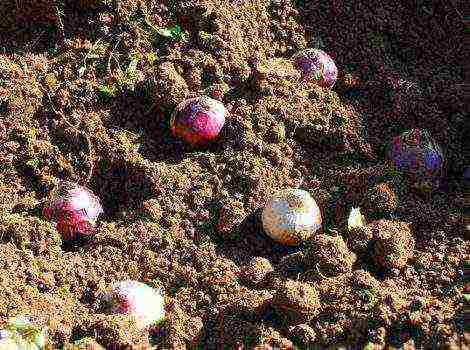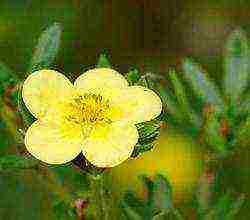Content [show]
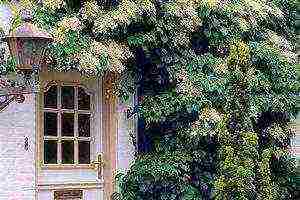
In the literature, you can find the name hydrangia petiolaris - this, translated from the Latin language, is the petiolate hydrangea (curly).
Climbing hydrangea is used as a hedge, to create pergolas or as a ground cover plant. This decorative liana is adapted for growing in the middle lane, so many varieties are wind-resistant and frost-resistant.
Such representatives are hydrangeas of the "Miranda" variety - a yellowish border on the leaf blade and the "Teik e Chance" variety - the color of the leaves is white marble.
Choosing a site for planting hydrangia petiolaris
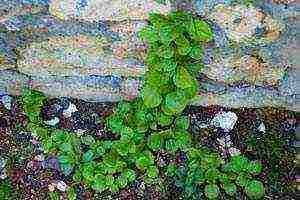 Hydrangeas prefer places with diffused light, grow well in partial shade. Avoid planting these vines in the vicinity of large trees or bushes.
Hydrangeas prefer places with diffused light, grow well in partial shade. Avoid planting these vines in the vicinity of large trees or bushes.
Light, loose, moderately moist soil with drainage is suitable.
It grows poorly on sandy soil and does not tolerate calcareous soils at all.
It is interesting: the color of hydrangea inflorescences depends on the pH of the soil. On neutral soils - white flowers, with an acid reaction, blue shades will be observed, and with an alkaline pH, the inflorescences turn pink.
It is good to use a mixture of humus, peat, fertile soil and sand as a substrate in a ratio of 2: 1: 2: 1.
Landing
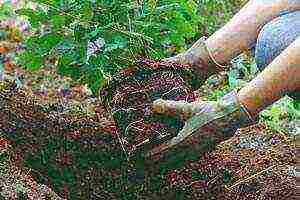 Young plants are planted at the age of 2-3 years in open ground. This is done in early April or autumn.
Young plants are planted at the age of 2-3 years in open ground. This is done in early April or autumn.
This type of hydrangea is a climbing plant, so it is worthwhile to provide a support in advance. When group planting hydrangia, it is necessary to observe the interval between them. Usually one meter is enough.
A hole is dug half a meter deep, 50 cm wide, a drainage layer 5–10 cm thick is placed on the bottom. Broken brick, gravel, pebbles, expanded clay can be used as drainage. This is followed by a ten-centimeter layer of fertile soil. The roots of the seedling are carefully spread in the hole, they will grow in width.
Then they fill up the earth. The root collar should be at ground level.
It's important to know: hydrangea is a poisonous vine. It contains cyanogenic glycosides.
The basis for caring for hydrangeas is their timely pruning. But ground cover hydrangia need only sanitary care.
Watering
 After planting, the plants are watered abundantly. For one plant about 20 liters of water.
After planting, the plants are watered abundantly. For one plant about 20 liters of water.
The water should be soft, slightly acidic. Rainwater works well. It is necessary to water hydrangeas every week - this is a moisture-loving plant. In addition, seedlings need to be watered every other day, especially in dry weather.
Bloom from June to August, depending on the variety.
Note: an important step is mulching. The ground is covered with peat chips or sprinkled with crushed bark or sawdust. This procedure is needed to retain moisture in the soil.
Care
 Further care of the seedlings includes:
Further care of the seedlings includes:
- top dressing. It is recommended to apply complex mineral fertilizer 2–4 times per season. In the autumn, add 100 g of wood ash per square meter;
- loosening the soil. Usually carried out in parallel with weeding several times per season;
- pruning. To create powerful shoots in young hydrangeas, formative pruning is carried out in early spring, when the first buds have just appeared.
For old vines, you can carry out anti-aging pruning.
Subject to all growing conditions and proper care, climbing hydrangea will delight with its motley colored leaves and fragrant abundant flowering every year.
From this video you will learn about the varieties and types of hydrangea:
Rate the article
(
estimates, average:
out of 5)
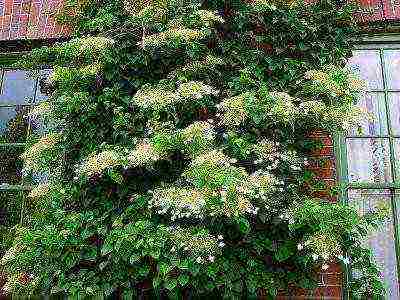
In the natural conditions of Sakhalin and Japan, this hydrangea - a deciduous liana with aerial roots and suckers, capable of climbing rocks and trees, and on open flat areas - creeping along the ground. The length of its shoots reaches 25 meters.
…
Description and features of the variety
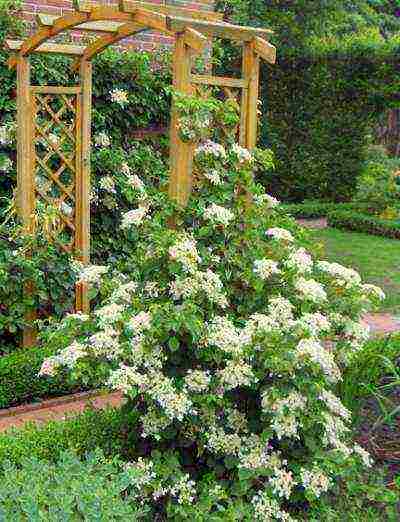
In culture, this plant - windproof, easily tolerating a gas-polluted atmosphere - a wonderful vertical "greenery" with fragrant honey inflorescences. In autumn, the foliage takes on a pale yellow color.
The cultivated "rock climber" is represented by a variety of decorative, abundantly flowering and variegated forms, including frost-resistant ones.
So, the foliage of the climbing hydrangea Miranda decorated with an irregular yellow or yellow-cream border, and Take a Chance has a white border or white marble color of the entire sheet plate. Both varieties are resistant to the typical temperature conditions of midwinter winters.
Planting and caring for climbing hydrangea
Seat selection
The place for planting climbing hydrangea for vertical gardening should provide for appropriate support (wall, arch, tree trunk) and enough good lighting - not only direct, but also diffused light, up to partial shade.
Due to competition for soil moisture, the proximity of large trees and garden shrubs is undesirable.
This flowering vine can also become a ground cover that strengthens the slopes.
Priming
The soil must be sufficient light, fertile, well-drained, acidic - for example, you can use a mixture of peat, humus and garden soil or mix humus, fertile soil, peat and sand in proportion 2:2:1:1.
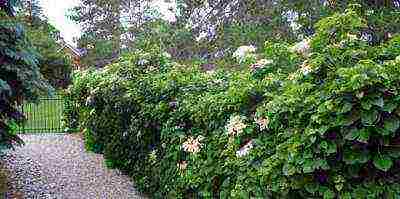 Landing
Landing
The best time to land in open ground is early spring or autumn... The best option is two to three year old seedlings. The distance from one plant to another in a group planting is one meter.
The planting pit should be sized to provide sufficient space for the seedling's root system to grow. The usual scales are 40 cm long and 50 cm deep.
A ten-centimeter drainage layer of pebbles, expanded clay, brick or ceramic battle is laid at the bottom.
In the prepared planting pit, a layer of soil mixture with a thickness of 10-15 cm is placed, and then a carefully spread moist root system, which will grow mainly in breadth.
They fill up the soil, carefully compacting it. As a result the root collar should be flush with the soil surface - but not deeper.
ATTENTION: Water abundantly, then the surface of the earth is mulched peat chips or crushed bark. This last operation is necessary in order for the soil under the bush to retain moisture longer.
Watering
IMPORTANT: Optimum irrigation the water should be soft, the ideal option is irrigation with rainwater.
 Water from the water supply network should settle well and warm up, and from time to time it is useful add a small amount of lemon juice or vinegar.
Water from the water supply network should settle well and warm up, and from time to time it is useful add a small amount of lemon juice or vinegar.
In dry summers, systematic abundant watering is necessary: two buckets of water for each liana weekly.
Spraying
In dry summers, young seedlings, in addition to watering, need regular spraying.
Top dressing
Plant during the period of active growth responds well to monthly feeding complex mineral fertilizers that can be supplemented with organic compounds.
Growth and pruning
Young plants develop slowly and only by the age of three do they begin to form really long, powerful shoots.
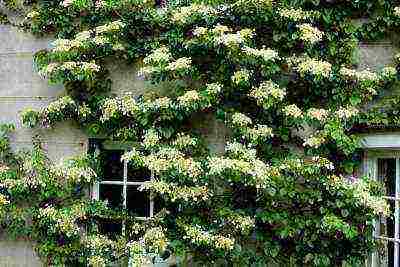 An adult liana growing rapidly along vertical supports (up to a meter per season) regular intensive shaping pruning is required... In this case, the main stems are properly guided and tied up, and the "wrong" ones are cut, stimulating the further growth of new shoots in the right direction.
An adult liana growing rapidly along vertical supports (up to a meter per season) regular intensive shaping pruning is required... In this case, the main stems are properly guided and tied up, and the "wrong" ones are cut, stimulating the further growth of new shoots in the right direction.
To ensure maximum coverage and powerful inflorescences, vigorous pruning is carried out in early spring, leaving some of the shoots with only two to six buds.
If this hydrangea is used as a ground cover plant, it is not subjected to targeted pruning, but only damaged, dried, weak shoots are removed.
Wintering
Adult curly hydrangeas do not need winter shelter, but young plants better bend to the ground and cover with spruce branches... It is also useful to mulch the root system area with peat chips.
Bloom
Blossoming season - summer: June July.
Coloration inflorescences depends on the acidity of the soil: flowers that are white in neutral ground take on blue tints in an acidic substrate.
This property of hydrangeas is widely used, especially since acidified, soft water is beneficial for plants.
Flowers are also "blue" with a special soil dye, which is available on the market.
 Reproduction
Reproduction
Seeds of climbing hydrangea, as a rule, ripen in the middle lane, however, the seed method of reproduction is rarely used due to the short period during which the seeds remain viable. Sowing falls, in this case, in the fall. As a result germinating seeds and preserving seedlings requires a lot of effort maintaining light, temperature and humidity conditions. Therefore, these hydrangeas practically multiply. vegetatively: layering and cuttings.
- Reproduction by layering. In early May or in August, the lower branch is bent to the ground, slightly incised in the middle and fixed. Then it is slightly buried and added dropwise in this place. The top of the branch is tied to a support to give it an upright position. By the next spring, the buried part forms a sufficient root system and then the new plant can be separated from the mother.
- Propagation by cuttingsand. Summer, June, cuttings up to 15 cm long are cut from lignified shoots. The lower sections are treated with a rooting stimulant. They are planted obliquely in a nutritious soil and covered; maintain humidity, ventilate and, before the formation of the first new shoots, protect from direct sunlight. Rooting usually takes no more than a month.
Diseases and pests
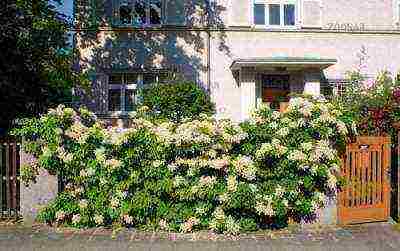
Hydrangea in an area with optimal conditions for it is resistant to diseases.
If the soil is limescale or oversaturated with humus, the plant may develop chlorosis, in which the leaves, with the exception of the central vein, become yellow-light.
In this case, watering is carried out potassium nitrate solution with a concentration of 4g / l, and after 3 days - ferrous sulfate solution the same concentration.
Downy mildew, in which dark oily, gradually spreading spots are formed on the leaves and stems, it affects the hydrangea at a temperature of 18-20 degrees in combination with high atmospheric humidity.
An effective remedy for this disease is spraying with copper-soap solution: 15 g copper sulfate and 150 g green soap in a bucket of water.
Gray rot, which also develops in summer with high air humidity, requires the removal of affected leaves and shoots, followed by treatment of the bush fungicides.
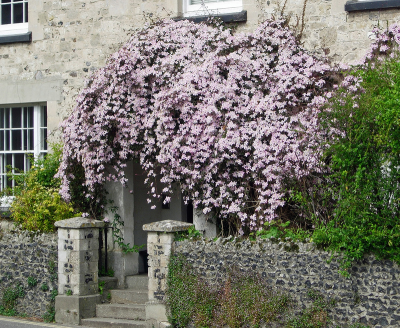 If the humidity of the air is lowered, the plant settles aphids and spider miteswhich can be removed with soapy water.
If the humidity of the air is lowered, the plant settles aphids and spider miteswhich can be removed with soapy water.
However, the most effective in such cases is the use of systemic insecticides.
As a preventive measure, you should get rid of weeds that serve as a haven and breeding ground for these pests.
Climbing hydrangea (petiolate, climbing) is one of the few frost-resistant vines that bloom profusely in the cool summer of the middle zone.
The cultivation of spectacular variegated, aromatic honey varieties in garden culture is not very difficult.
A plant planted in acidified, fertile, drained, well-hydrated soil responds to optimal conditions with lush growth and lush flowering.
Photo
For more photos of curly hydrangea, see below: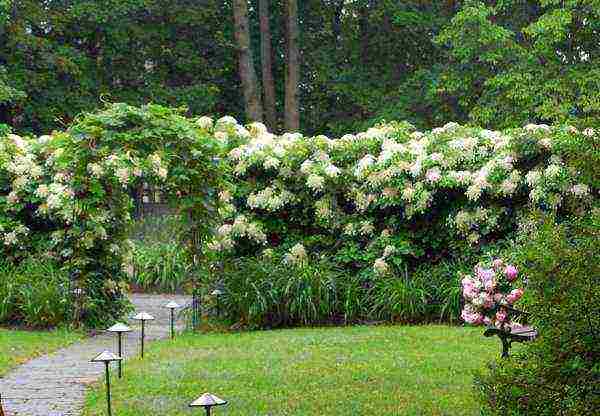
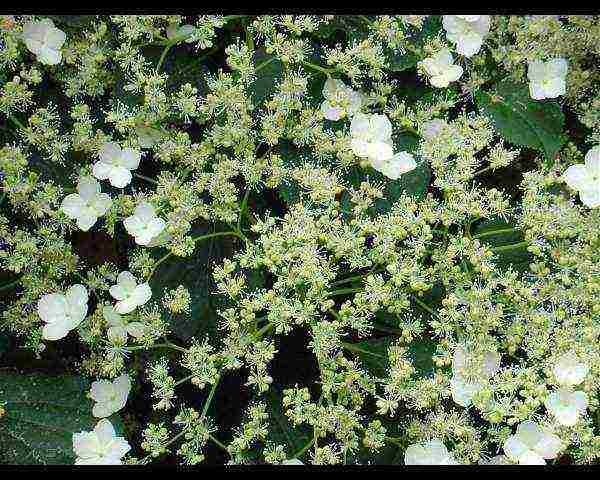

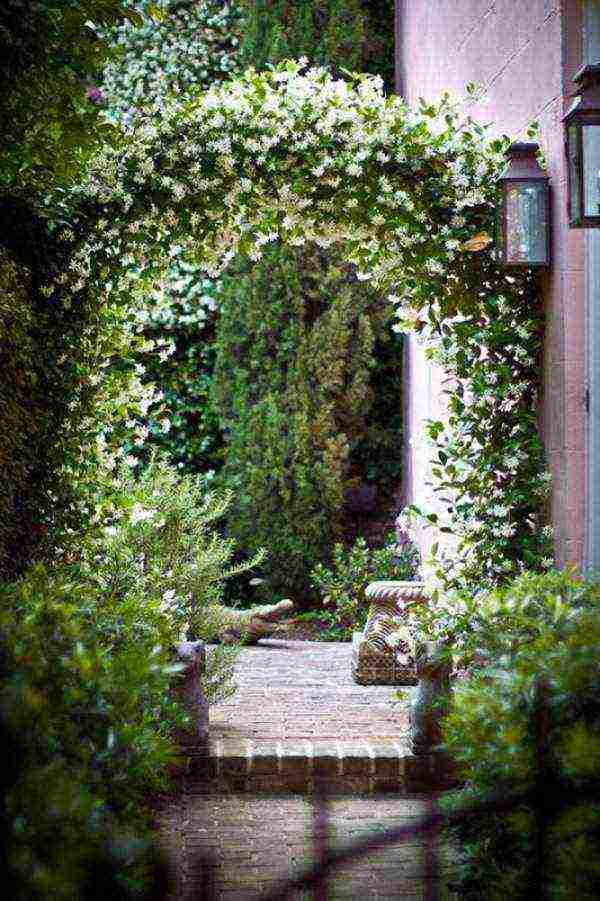

Useful video
You can look at the petioled hydrangea in the video:
Helpful information
You can familiarize yourself with other materials about garden hydrangea:
- How to properly care for Bobo panicle hydrangea? Growing and preparing for winter
- How to properly care for my Limelight hydrangea?
- How does Oakleaf hydrangea winter?
- Frost-resistant Pinky Winky hydrangea on your site
- Hydrangea paniculata grandiflora - features of care and reproduction in the garden
- Hydrangea tree annabelle - a snow-white decoration of your site
- Tree hydrangea in your garden - planting and care, reproduction, wintering
- How to make friends with a serrated hydrangea?
- Japanese hydrangea Kyushu in your garden
- Frost-resistant hydrangea large-leaved
- How to properly care for a phantom panicle hydrangea? Planting, wintering, reproduction
- How to properly care for panicle hydrangea vanilla fries?
- Fragrant "princess" hydrangea paniculata in your garden: care features
- Breeding secrets of garden hydrangea
- Garden hydrangea: planting and care, neighborhood in the garden
- Don't let your garden hydrangea freeze! How to cover a hydrangea for the winter?
- How to protect your garden hydrangea from diseases and pests?
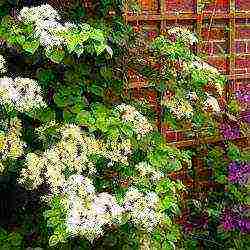 Hydrangea creeping or petiole is an unusual plant. She smells of honey, grows up to 10 m, and is beautiful both in the photo and in the garden. She needs proper care to grow well. The article will tell you about the nuances of planting and growing hydrangeas.
Hydrangea creeping or petiole is an unusual plant. She smells of honey, grows up to 10 m, and is beautiful both in the photo and in the garden. She needs proper care to grow well. The article will tell you about the nuances of planting and growing hydrangeas.
Varieties and varieties of petioled hydrangea
This plant is a subspecies of garden hydrangea. And in the photo and in reality, it looks like a liana, which can braid trees and various objects in the garden, decorate a hedge, grow along the wall of the house. Aerial roots and special suction cups help her in this. Stalked hydrangea is characterized by high winter hardiness, adult bushes can withstand not prolonged frosts down to -30 °. Due to its dense foliage, this plant shades windows well, not letting the summer heat into the house.
The most popular are the following varieties of petiole hydrangea:
- Miranda. Has a sweet smell. The leaves are dark, light green, with white veins, wide, pointed in shape;

Variety Miranda
- Curly liana. It has an interesting feature: with the help of various dyes, the white flowers of this hydrangea can be given any shade;
- Cordifolia. Its inflorescences look like small panicles and smell delicious of honey;
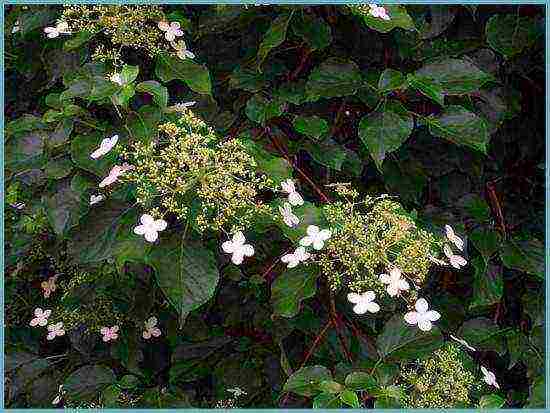
Cordifolia variety
- Petiolaris. A favorite of landscape designers. This is the tallest variety of petioled hydrangea, it grows up to 25 m. It spreads along the ground or braids trees.
Planting a plant
- The best time for this is spring. The place should be protected from wind and direct sunlight. Absolute shade will not work as the hydrangea will not bloom abundantly.
- Choose a loose, moist, slightly acidic soil. Its optimal composition is peat, sand and earth, in which the plant was located before planting. Mix everything in equal parts.
Attention! A planting hole for a hydrangea, which is rooted from a container, should be 2 times the size of the container.
- The roots should be spread in different directions. Deepening the root collar when planting a seedling is permissible only by 2-3 cm. Otherwise, the plant will develop poorly.
- The ground around must be carefully tamped to prevent the appearance of empty spaces: because of them, the roots may experience a moisture deficit.
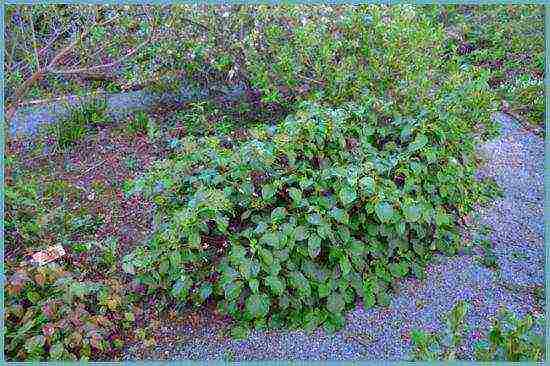
Planting hydrangeas in the spring
- After planting, the bush needs to be watered well. Hydrangea loves moisture very much, so it is advisable to saturate the soil with water to a depth of about 0.5 m.
- The plant will gratefully respond to mulching with peat or, for example, bark.The approximate layer thickness is 7-10 cm.
Advice. The best time to apply mulch is late spring. In the fall, add it after a stable subzero temperature is established.
Hydrangea care
The basis of caring for this plant is watering about once every 10-15 days. In the first year, it must be very thorough. Hydrangea roots cannot take enough moisture from the soil. Therefore, saving on watering, you run the risk of ruining a young seedling.
Advice. In the warm season, petiole hydrangea requires a particularly large amount of moisture and air. If possible, install a sprayer next to the seedling.
If your plant, as if in a picture or photo, spreads over a beautiful carpet, you do not need to cut it off. You should only periodically remove dead or diseased processes. If the hydrangea grows vertically, its shoots must be regularly shortened, directed their growth in the right direction and be sure to make support for them. Pruning promotes abundant lateral branches, which create a dense canopy.
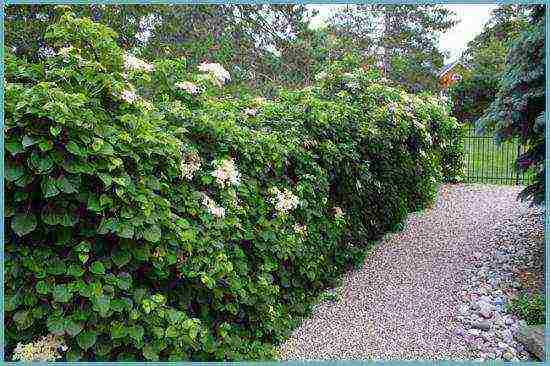
Hydrangea tolerates haircuts very well
Despite the fact that the petioled hydrangea is considered to be quite resistant to frost and is grown even in Siberia, young plants in the first few years still need to be covered for the winter. To do this, shoots should be carefully laid on boards and covered with spruce branches or fallen leaves. This is especially true for those owners of personal plots who live in the northern regions.
Fertilizing and feeding petiolate hydrangea
In order for the liana to bloom magnificently and develop well, it needs top dressing with organics and minerals. You can use special ready-made fertilizers for hydrangeas. They contain a lot of magnesium and iron, thanks to which the plant grows quickly, and its foliage has a rich color. It is useful to apply fertilizers before planting, as well as during intensive development.

Feed your hydrangea several times per season
Plan the first feeding in late spring or early summer. To do this, use 1 part poultry manure diluted with 10 parts water. Also add to the soil a mineral fertilizer consisting of superphosphate, potassium nitrate and urea. The proportions are 2: 1: 1. Re-apply top dressing, observing an interval of 1 time in 2 weeks.
Advice. To make the hydrangea woody for the winter, stop fertilizing it from late summer or early August.
Plant propagation
Hydrangea breeding methods are traditional, as for many horticultural crops:
- division;
- cuttings;
- reproduction by layering.
If a bush gives abundant growth, good seedlings can be obtained by separating young shoots from it. They need to be shortened to several buds, and the root should be cut a little and treated with potassium permanganate. Having planted shoots in the holes, they should be abundantly moistened within a month. The best time for this is spring.
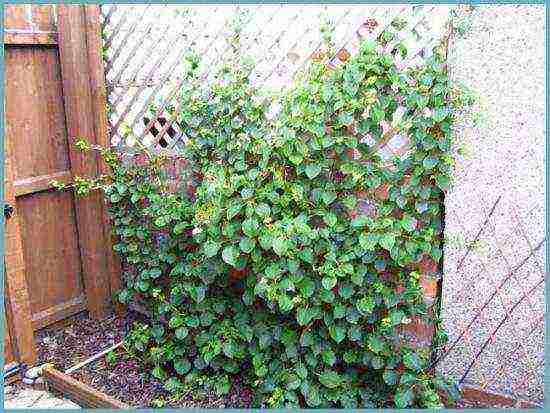
It is most convenient to propagate hydrangea by layering.
When choosing a grafting method, use a maximum of 15 cm cuttings that are lignified. The beginning of summer is optimal for this breeding method. From the shoot, which has 2 nodes, you need to cut off the top and remove a couple of lower leaves. The stalk treated with a growth stimulant is placed in a box with peat and sand. It is necessary to monitor the moisture content of the mixture, and cover the container itself with a film. It is removed when the plant gets stronger.
For reproduction by layering, you need to very carefully pin the lower branch to the ground. Please note that the soil must be moist and loose. Where the branch touches the ground, an incision is made and mulched with peat. It is better to do this in early May or August.
Diseases and pests of hydrangea
If the leaves of your plant have lightened, it is likely that chlorosis has overcome it. This disease occurs if the soil contains a lot of humus. Another reason is the excess of lime in the ground. Hydrangea is very sensitive to this component. Sometimes the vine is damaged by powdery mildew or gray rot.To prevent this, do not overdo nitrogen fertilization and watering, especially during the rainy season. To fight diseases, you can use, for example, Bordeaux liquid.
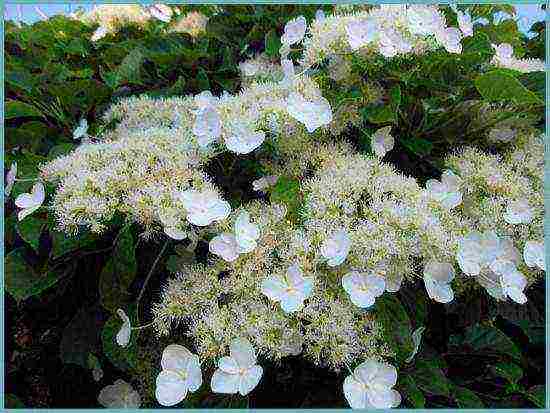
Hydrangea bloom
Hydrangea is susceptible to insect attacks, including spider mites, thrips and aphids. The latter is more prevalent in indoor plants. To kill pests, you need to apply insecticides. Every season, do 2 treatments at intervals of a week. By following all the recommendations, you will get a healthier and more beautiful plant that will become a luxurious accent of your garden.
Hydrangea in the garden: video
Types and varieties of hydrangea: photo
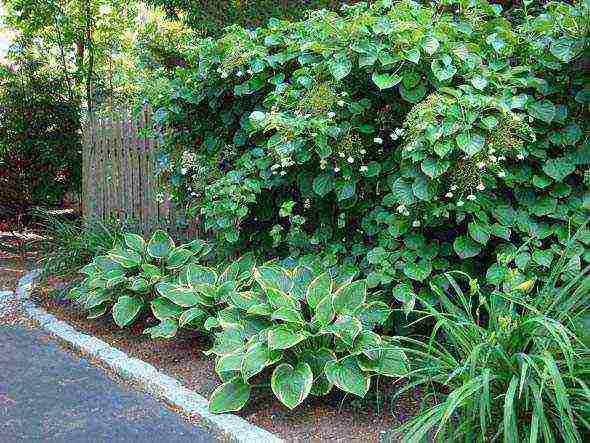

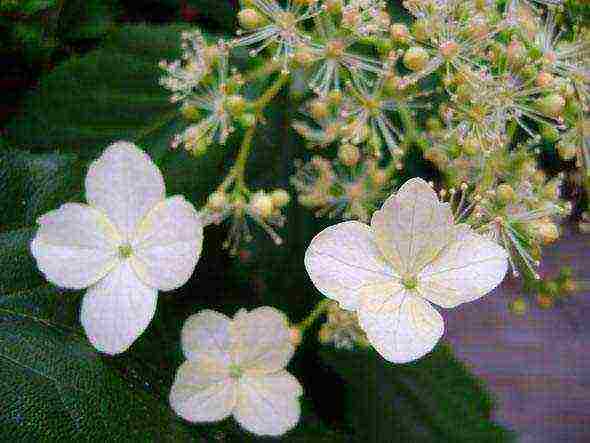
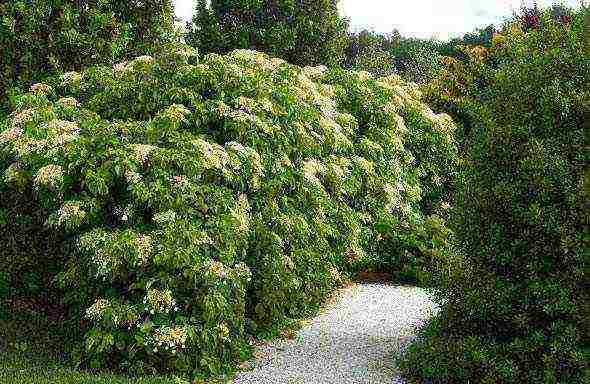


Curly hydrangea is currently very popular. The plant is quite wind-resistant and is an excellent vertical gardener with fragrant inflorescences. In the autumn, the leaves have a pale yellow tint.
In natural conditions, it grows on Sakhalin and Japan. It is a deciduous vine with aerial roots and suckers, capable of climbing trees and rocks, and on open flat surfaces - to creep along the surface. Shoots can be up to 25 meters long.
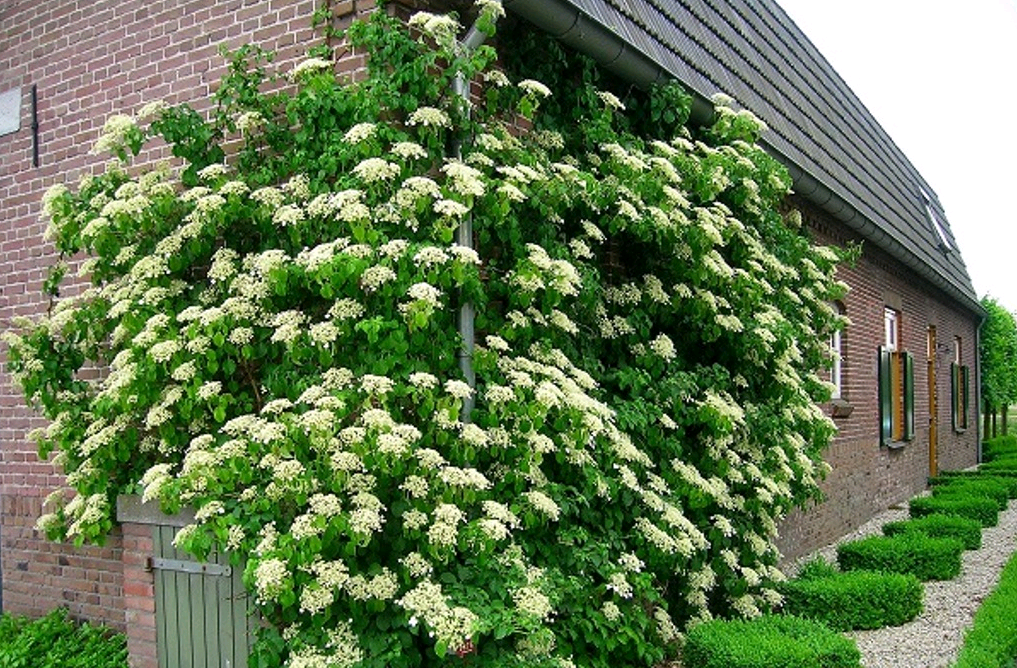
Manifold
There are many decorative forms of this plant, abundantly flowering and variegated, as well as frost-resistant.
Known species:
- "Miranda" - has foliage with an uneven yellow border;
- "Take a Chance" - has a white border or white - marbled foliage.
These species are quite resistant to the natural conditions of central Russia.
Pick-up location
Before planting a climbing hydrangea in your garden, you need to worry about the presence of a support nearby, for example, a wall or an arch. The site chosen for planting must be well lit.
It must be remembered that hydrangea loves moisture very much. Therefore, it is better to avoid the presence of other neighboring plants next to it.
When growing, it is worth considering the nuances that will help avoid rotting or drying out of the plant.
This flowering vine can also become a ground cover that strengthens the slopes.
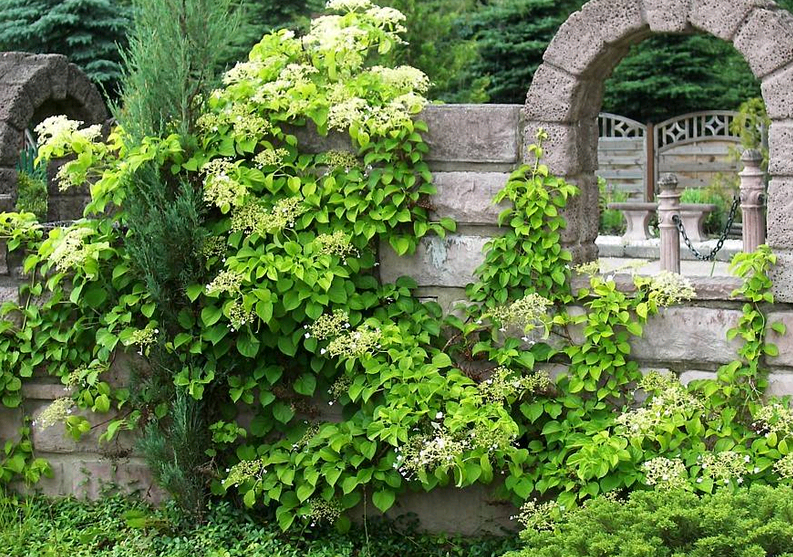
Planting soil
Hydrangea prefers light, well-drained, fertile soil with an acidic reaction. Acidification ensures the introduction of peat or humus.
Landing
The best time to plant hydrangeas outdoors is early spring or early fall. The planting hole should be deep enough to allow the free position of the root system. Its dimensions should be at least 40 x 50 cm. To ensure good drainage, pebbles or expanded clay should be laid at the very bottom.
A soil mixture is placed on top with a layer of 10-15 cm, the root system is carefully placed on it and the soil is poured. At the end, it is well sealed. The root collar should be at ground level, not deeper. The planted plant is watered abundantly, and the surface of the soil is sprinkled with crushed bark to maintain moisture for a long time.
For group plantings, the distance between seedlings should be at least 1 meter.
Care
Plants should be watered with soft water, which is why rainwater is the best option. The water from the well must certainly be warmed up. To acidify it, you can add lemon juice or a small amount of vinegar. In summer, hydrangea should be watered abundantly. In addition to watering, the plant also needs daily spraying. The plant should be fed with complex mineral fertilizers - once a month, organic compounds can also be used. Educated long, powerful shoots of hydrangea should be regularly pruned to stimulate further growth and formation of the vine. The main shoots are tied up and properly guided.
June - July is the most blooming season for hydrangeas. It is at this moment that she will delight you with her amazing colors and will serve as an excellent decoration on your site.
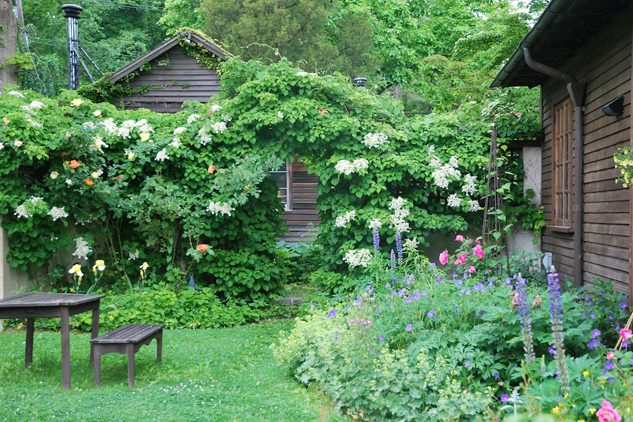
The color of the inflorescences directly depends on the acidity of the earth. For example, white inflorescences in neutral soil take on a bluish tint in an acidic substrate. Flowers can be tinted with a special potting dye available from the store.
Reproduction
Curly hydrangea can reproduce:
- Seeds;
- Layers;
- Cuttings.
The seed method is rarely used due to the fact that hydrangea seeds quickly lose their germination.
Reproduction by layering as in Kampsis. At the very beginning of May or at the end of summer, bend the lower branch to the ground, cut it a little in the middle and fix it. Then they are buried in this place. The very top of the plant is fixed to the support. The next spring, when the buried part forms the root system, the daughter plant can be separated from the mother and planted separately.

Propagation by cuttings. In June, cuttings up to 10-15 centimeters long are cut from the shoots. The lower, cut parts are treated with a root formation stimulator.
Then, the cuttings are planted in a nutritious soil and covered with a film. Rooting takes place within 30 days.
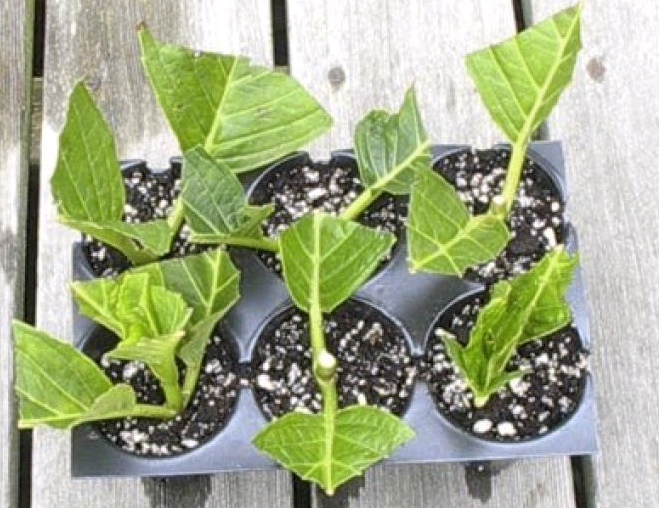
Diseases and pests
Hydrangea is quite disease resistant. The most common ones are:
- Chlorosis - occurs when the soil is oversaturated with humus; characterized by the appearance of light yellow foliage;
- Downy mildew - appears at a temperature of 18-20 degrees and high humidity; characterized by the appearance of dark oily spots on the leaves and stems;
- Gray rot - develops in high humidity.
In the fight against diseases, they help:
- Solutions of potassium nitrate and ferrous sulfate with chlorosis;
- Copper-soap solutions for downy mildew;
- Fungicides for gray rot.
In cases where the air humidity is low enough, then there is a high probability of being affected by aphids and spider mites. They are removed with soap solutions or systemic insecticides.
For the prevention of diseases, weeds should be got rid of in time.
Wintering
An adult climbing hydrangea does not need shelter for the winter, and young plants must be bent to the ground and covered with spruce branches.

Thus, the cultivation of a variegated, fragrant beauty as a garden crop is not very difficult. And for the care and optimally created conditions, the hydrangea is responsible for lush growth and lush flowering.
